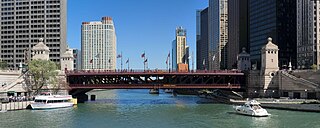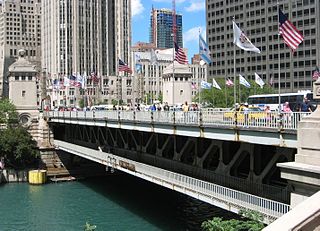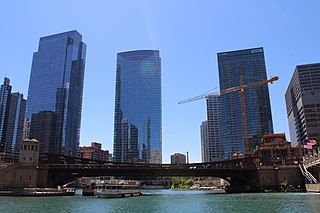
Jean Baptiste Point du Sable is regarded as the first permanent non-Indigenous settler of what would later become Chicago, Illinois, and is recognized as the "Founder of Chicago". A school, museum, harbor, park, bridge, and road have been named in his honor. The site where he settled near the mouth of the Chicago River around the 1780s is identified as a National Historic Landmark, now located in Pioneer Court.

Fort Dearborn was a United States fort built in 1803 beside the Chicago River, in what is now Chicago, Illinois. It was constructed by troops under Captain John Whistler and named in honor of Henry Dearborn, then United States Secretary of War. The original fort was destroyed following the Battle of Fort Dearborn during the War of 1812, and a second fort was constructed on the same site in 1816. By 1837, the fort had been de-commissioned.

The John Hancock Center is a 100-story, 1,128-foot supertall skyscraper located in Chicago, Illinois. Located in the Magnificent Mile district, the building was officially renamed 875 North Michigan Avenue in 2018.

The Chicago River is a system of rivers and canals with a combined length of 156 miles (251 km) that runs through the city of Chicago, including its center. Though not especially long, the river is notable because it is one of the reasons for Chicago's geographic importance: the related Chicago Portage is a link between the Great Lakes and the Mississippi River Basin, and ultimately the Gulf of Mexico.

The Tribune Tower is a 463-foot-tall (141 m), 36-floor neo-Gothic skyscraper located at 435 North Michigan Avenue in Chicago, Illinois, United States. Built between 1923 and 1925, the international design competition for the tower became a historic event in 20th-century architecture.

Streeterville is a neighborhood in the Near North Side community area of Chicago, Illinois, United States, north of the Chicago River. It is bounded by the river on the south, the Magnificent Mile portion of Michigan Avenue on the west, and Lake Michigan on the north and east, according to most sources, although the City of Chicago only recognizes a small portion of this region as Streeterville. Thus, it can be described as the Magnificent Mile plus all land east of it. The tourist attraction of Navy Pier extends out into the lake from southern Streeterville. The majority of the land in this neighborhood is reclaimed sandbar.

Lakeshore East is a master-planned mixed use urban development being built by the Magellan Development Group in the Loop community area of Chicago in Cook County, Illinois, United States. It is located in the northeastern part of the Loop, which, along with Illinois Center, is called the New Eastside. The development is bordered by Wacker Drive to the north, Columbus Drive to the west, Lake Shore Drive to the east, and East Randolph Street to the south. Skidmore, Owings & Merrill created the master plan for the area. The development, which had been scheduled for completion in 2011, was set for completion in 2013 by 2008. Development continued with revised plans for more buildings in 2018 and continuing construction of the Vista Tower in 2019.

333 South Wabash is a 600-ft, 44-story skyscraper located at 333 South Wabash Avenue in the central business district of Chicago, Illinois.

The DuSable Bridge is a bascule bridge that carries Michigan Avenue across the main stem of the Chicago River in downtown Chicago, Illinois, United States. The bridge was proposed in the early 20th century as part of a plan to link Chicago's south side and north side parks with a grand boulevard. Construction of the bridge started in 1918, it opened to traffic in 1920, and decorative work was completed in 1928. The bridge provides passage for vehicles and pedestrians on two levels. An example of a fixed trunnion bascule bridge, it may be raised to allow tall ships and boats to pass underneath. The bridge is included in the Michigan–Wacker Historic District and has been designated as a Chicago Landmark.

The Jean Baptiste Point Du Sable Homesite is the location where, around the 1780s, Jean Baptiste Point du Sable located his home and trading post. This home is generally considered to be the first permanent, non-native, residence in Chicago, Illinois. The site of Point du Sable's home is now partially occupied by and commemorated in Pioneer Court at 401 N. Michigan Avenue in the Near North Side community area of Chicago, Illinois.

333 North Michigan is a skyscraper in the art deco style located in the Loop community area of Chicago, Illinois in the United States. Architecturally, it is noted for its dramatic upper-level setbacks that were inspired by the 1923 skyscraper zoning laws. Geographically, it is known as one of the four 1920s flanks of the Michigan Avenue Bridge that are contributing properties to the Michigan–Wacker Historic District, which is a U.S. Registered Historic District.

Pioneer Court is a plaza located near the junction of the Chicago River and Upper Michigan Avenue in Chicago's Magnificent Mile. It is believed to be the site of Jean Baptiste Point du Sable's original residence and trading post. In 1965, the plaza was built on the former site of his homestead as part of the construction of the Equitable Life Assurance Society of America building. The Jean Baptiste Point Du Sable Homesite was designated as a National Historic Landmark on May 11, 1976. John Kinzie, a prominent early settler, bought and expanded Point du Sable's post in 1800. The Plaza is bounded on the north by the Tribune Tower, on the east by 401 N. Michigan Avenue, on the south by the Chicago River, and on the west by Michigan Avenue, adjacent to the DuSable Bridge. In 2017, a newly designed Apple Inc. store was opened on the south side of the court, which created new levels linking down to the river.

Rush Street is a one-way street in the Near North Side community area of Chicago in Cook County, Illinois, United States. The street, which starts at the Chicago River between Wabash and North Michigan Avenues, runs directly north until it slants on a diagonal as it crosses Chicago Avenue then it continues to Cedar and State Streets, making it slightly less than a mile long. One lane also runs southbound from Ohio Street (600N) to Kinzie Street (400N) as part of a two-way street segment. It runs parallel to and one block west of the Magnificent Mile on the two-way traffic North Michigan Avenue, which runs at 100 east up to 950 north. The street, which is also one block east of the one-way southbound Wabash Avenue, formerly ran slightly further south to the Chicago River where over time various bridges connected it to the Loop, Chicago's central business district.

The Railway Exchange Building, also known as Santa Fe Building, is a 17-story office building in the Historic Michigan Boulevard District of the Loop community area of Chicago in Cook County, Illinois, United States. It was designed by Frederick P. Dinkelberg of D. H. Burnham & Company in the Chicago style. Dinkelberg was also the associate designer to Daniel Burnham for the Flatiron Building in New York City.

The Michigan–Wacker Historic District is a National Register of Historic Places District that includes parts of the Chicago Loop and Near North Side community areas in Chicago, Illinois, United States. The district is known for the Chicago River, two bridges that cross it, and eleven high rise and skyscraper buildings erected in the 1920s. Among the contributing properties are the following Chicago Landmark structures:

Wolf Point is the location at the confluence of the North, South and Main Branches of the Chicago River in the present day Near North Side, Loop, and Near West Side community areas of Chicago. This fork in the river is historically important in the development of early Chicago. Located about 1.6 miles (2.6 km) from Lake Michigan, this was the location of Chicago's first three taverns, its first hotel, Sauganash Hotel, its first ferry, its first drug store, its first church, its first theater company, and the first bridges across the Chicago River. The name is said to possibly derive from a Native American Chief whose name translated to wolf, but alternate theories exist.

The Riverside Plaza is considered one of Chicago's finest Art Deco buildings. It was originally known as the Chicago Daily News Building. At the time of its completion in 1929, the Daily News was one of the dominant newspapers in Chicago. The 26-story building helped revitalize the Chicago River and made innovations in engineering and urban design.


















